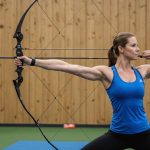Ultimate Shoulder Injury Prevention: Key Strength Training Exercises Every Athlete Should Master
Understanding the Importance of Shoulder Health
Shoulder health is a critical aspect of athletic performance and overall well-being, particularly for athletes involved in sports that require repetitive overhead movements, such as swimming, wrestling, and tennis. The shoulder joint, being a complex and highly mobile ball-and-socket joint, is prone to injuries due to its shallow socket and the extensive range of motion it allows.
“Shoulder injuries account for 24 percent of all injuries in high school wrestlers,” highlights an article from Therapeutic Associates, emphasizing the need for proactive measures in maintaining shoulder health[3].
Topic to read : Winning strategies: harnessing match play data to boost tennis performance
The Role of the Rotator Cuff in Shoulder Stability
The rotator cuff, comprising four main muscles (supraspinatus, subscapularis, infraspinatus, and teres minor), plays a vital role in stabilizing the shoulder joint. These muscles work in harmony to facilitate movements such as lifting, rotating, and stabilizing the arm.
“Strengthening the rotator cuff is key to preventing injuries like tendinopathies, rotator cuff tears, and shoulder impingement syndrome,” explains PhysioWorks!, underscoring the importance of targeted exercises for these muscles[5].
Also read : Crucial strategies for bowlers to reduce lower back pain risk: a comprehensive guide
Essential Exercises for Shoulder Injury Prevention
Rotator Cuff Strengthening Exercises
To prevent shoulder injuries, it is crucial to incorporate exercises that specifically target the rotator cuff muscles.
External Rotations with Resistance Bands
- How to Perform:
- Attach a resistance band to a stable anchor at waist height.
- Stand sideways to the anchor and hold the band with the hand farthest from the anchor.
- Keep your elbow bent at a 90-degree angle and tucked into your side.
- Slowly rotate your arm outward, keeping the movement controlled.
- Return to the starting position.
- Reps and Sets: Perform 3 sets of 12–15 reps on each arm[1].
Internal Rotations with Resistance Bands
- How to Perform:
- Attach a resistance band to a stable anchor at waist height.
- Stand sideways to the anchor and hold the band with the hand farthest from the anchor.
- Keep your elbow bent at a 90-degree angle and tucked into your side.
- Slowly rotate your arm inward, keeping the movement controlled.
- Return to the starting position.
- Reps and Sets: Perform 3 sets of 12–15 reps on each arm[1].
Strengthening the Shoulder Girdle
In addition to rotator cuff exercises, strengthening the muscles of the shoulder girdle is essential for overall shoulder health.
Overhead Dumbbell Press
- How to Perform:
- Stand with your feet shoulder-width apart and hold a dumbbell in each hand at shoulder height.
- Engage your core to stabilize your body.
- Press the dumbbells overhead until your arms are fully extended.
- Slowly lower the dumbbells back to shoulder height.
- Reps and Sets: Start with 3 sets of 8–10 reps, using a weight that challenges you without compromising form[1].
Vasa Swim Trainer Pulls
- How to Perform:
- Lie on the Vasa Swim Trainer with your arms extended in front of you.
- Engage your core and maintain a streamlined body position.
- Perform a freestyle pull by pulling one arm down and back, keeping your elbow high, and engaging your lats.
- Alternate arms to mimic a swimming stroke.
- Reps and Sets: Perform 3 sets of 10–12 reps per arm[1].
Scapular Stability Exercises
Scapular stability is another critical component of shoulder health. Here are some exercises to target the scapular muscles:
Scapular Push-Ups
- How to Perform:
- Start in a high plank position, with hands under shoulders and core engaged.
- Without bending your elbows, squeeze your shoulder blades together.
- Push through your hands to separate your shoulder blades.
- Focus on slow, controlled movements[1].
Stretching and Mobility Exercises
In addition to strengthening exercises, incorporating stretching and mobility work is vital for maintaining flexibility and range of motion.
Resistance Band Stretches
Here are some effective resistance band stretches for the shoulders:
Front Raise
- How to Perform:
- Stand straight with your legs knee-width apart and place a resistance band under your feet while holding the ends with your hands.
- Slowly raise the bands simultaneously until they reach shoulder height, then return to the starting position.
- Tips: Avoid using momentum and keep your core engaged throughout the exercise[2].
Single-Arm Side Raise
- How to Perform:
- Hold the resistance band with one hand while standing on the other end of the band.
- Raise your arm until it is level with your shoulder, then return to the starting position.
- Tips: Adjust the length of the band to change the resistance and face your palm inward with your elbow slightly bent[2].
Pull-Apart
- How to Perform:
- Hold a resistance band between both hands.
- With your back straight and elbows slightly bent, pull the band back with your hands so that your shoulder blades move closer together.
- Hold this position, then slowly release back to the starting position[2].
Practical Tips for Athletes
Gradual Progression
- Gradually increase resistance and intensity to avoid overloading the muscles and tendons. This approach helps in building strength without risking injury.
Proper Form
- Prioritize proper form to avoid unnecessary strain on the shoulders. Incorrect form can lead to injuries and undermine the effectiveness of the exercises.
Core Engagement
- Engage your core during exercises to provide additional support to the shoulder. A strong core helps in stabilizing the body and reducing the risk of shoulder injuries.
The Role of Physical Therapy in Shoulder Injury Prevention
Physical therapy plays a crucial role in preventing and rehabilitating shoulder injuries. Here’s how:
Customized Exercise Programs
- A physical therapist can provide a personalized exercise plan tailored to your specific needs and condition. This ensures that you are targeting the right muscles and avoiding exacerbating any existing injuries.
Proprioceptive Training
- Proprioceptive training, using tools like balance boards or stability balls, helps improve neuromuscular control and joint awareness. This is particularly beneficial for athletes who need to maintain dynamic stability during their sports activities[3]. — Prioritizing Shoulder Health for Long-Term Success
Shoulder health is a cornerstone of athletic performance and overall well-being. By focusing on rotator cuff strengthening, scapular stability, and maintaining proper mobility, athletes can significantly reduce the risk of shoulder injuries.
“Building shoulder stability early improves performance, safeguards joint health, and helps wrestlers stay injury-free throughout their careers,” emphasizes Therapeutic Associates, a principle that applies to all athletes regardless of their sport[3].
Detailed Exercise List
Here is a detailed list of exercises that every athlete should master for ultimate shoulder injury prevention:
-
External Rotations with Resistance Bands:
-
Targets: Infraspinatus and teres minor
-
How to Perform: Attach a resistance band to a stable anchor, stand sideways, and rotate your arm outward.
-
Reps and Sets: 3 sets of 12–15 reps on each arm[1].
-
Internal Rotations with Resistance Bands:
-
Targets: Subscapularis, teres major, pectoralis major, deltoid, and latissimus dorsi
-
How to Perform: Attach a resistance band to a stable anchor, stand sideways, and rotate your arm inward.
-
Reps and Sets: 3 sets of 12–15 reps on each arm[1].
-
Overhead Dumbbell Press:
-
Targets: Deltoids, traps, and triceps
-
How to Perform: Stand with feet shoulder-width apart, hold dumbbells at shoulder height, and press them overhead.
-
Reps and Sets: 3 sets of 8–10 reps[1].
-
Vasa Swim Trainer Pulls:
-
Targets: Lats, shoulders, and triceps
-
How to Perform: Lie on the Vasa Swim Trainer, engage your core, and perform a freestyle pull.
-
Reps and Sets: 3 sets of 10–12 reps per arm[1].
-
Scapular Push-Ups:
-
Targets: Serratus anterior
-
How to Perform: Start in a high plank position, squeeze your shoulder blades together, and push through your hands.
-
Reps and Sets: Focus on slow, controlled movements[1].
-
Front Raise:
-
Targets: Front and side deltoids, serratus anterior, and bicep muscles
-
How to Perform: Stand straight, place a resistance band under your feet, and raise the bands to shoulder height.
-
Tips: Avoid using momentum and keep your core engaged[2].
-
Single-Arm Side Raise:
-
Targets: Medial deltoid
-
How to Perform: Hold the resistance band with one hand, raise your arm until it is level with your shoulder.
-
Tips: Adjust the length of the band and face your palm inward[2].
-
Pull-Apart:
-
Targets: Backs of the shoulders
-
How to Perform: Hold a resistance band between both hands, pull the band back to move your shoulder blades closer together.
-
Tips: Keep your back straight and elbows slightly bent[2].
Comparative Table of Exercises
Here is a comparative table of the exercises mentioned, highlighting their targets, how to perform them, and the recommended reps and sets:
| Exercise | Targets | How to Perform | Reps and Sets |
|---|---|---|---|
| External Rotations | Infraspinatus, teres minor | Attach band, stand sideways, rotate arm outward | 3 sets of 12–15 reps per arm |
| Internal Rotations | Subscapularis, teres major | Attach band, stand sideways, rotate arm inward | 3 sets of 12–15 reps per arm |
| Overhead Dumbbell Press | Deltoids, traps, triceps | Stand with feet shoulder-width apart, press dumbbells overhead | 3 sets of 8–10 reps |
| Vasa Swim Trainer Pulls | Lats, shoulders, triceps | Lie on Vasa Swim Trainer, engage core, perform freestyle pull | 3 sets of 10–12 reps per arm |
| Scapular Push-Ups | Serratus anterior | Start in high plank position, squeeze shoulder blades together | Focus on slow, controlled movements |
| Front Raise | Front and side deltoids, serratus anterior | Stand straight, place band under feet, raise bands to shoulder height | As needed |
| Single-Arm Side Raise | Medial deltoid | Hold band with one hand, raise arm until level with shoulder | As needed |
| Pull-Apart | Backs of the shoulders | Hold band between both hands, pull back to move shoulder blades closer together | As needed |
Quotes and Insights from Experts
-
“Shoulder stability is crucial for maintaining a full range of motion and avoiding injuries,” says PhysioWorks!, emphasizing the importance of targeted exercises for shoulder stability[5].
-
“Building shoulder stability early improves performance, safeguards joint health, and helps wrestlers stay injury-free throughout their careers,” notes Therapeutic Associates, highlighting the long-term benefits of proactive shoulder care[3].
-
“Strengthening the rotator cuff muscles is essential, but timing is everything. Premature strengthening can worsen an injury or delay healing,” advises PhysioWorks!, underscoring the need for professional guidance in developing an exercise plan[5].
By incorporating these exercises into your training regimen and following the practical tips and insights provided, athletes can significantly reduce the risk of shoulder injuries and maintain optimal shoulder health. Remember, prevention is key, and a well-structured strength training program is the foundation of long-term athletic success.
















